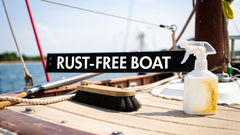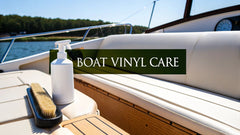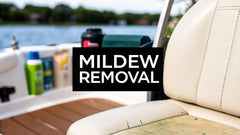7 Smart Boat Storage Ideas for 2025
Choosing the right storage for your boat is one of the most critical decisions you'll make as an owner. Proper storage protects your vessel from the elements, marine growth, and potential theft, directly preserving its value and extending its lifespan. Navigating the diverse landscape of boat storage ideas can be overwhelming, with options ranging from high-tech professional facilities to cost-effective home solutions. This guide simplifies the process by breaking down seven of the most effective and popular storage methods available.
We will explore the specific features, pros, cons, and actionable tips for each option, empowering you to make an informed choice that fits your boat, budget, and lifestyle. Understanding these solutions is key to ensuring your investment remains secure and ready for your next adventure on the water. Beyond boat-specific facilities, you might explore various storage solutions that could accommodate your vessel, depending on its size and type. From dry stack facilities and marina wet slips to shrink-wrapping systems and simple driveway storage, we'll provide the practical details you need. This comprehensive roundup is designed to give you a clear, actionable path toward selecting the perfect long-term home for your boat.
1. Dry Stack Storage Facilities
Dry stack storage is a premium, professional solution for boat owners seeking maximum protection and convenience. Instead of leaving your boat in a wet slip, this service uses a powerful marine forklift to lift your vessel directly from the water and place it into a secure, multi-level rack system inside a large warehouse. This method completely removes the boat from the marine environment, offering one of the best boat storage ideas for long-term preservation and security.
Leading providers like Safe Harbor Marinas and Suntex Marinas have perfected this "boat valet" service. When you want to use your boat, you simply call ahead, and the staff will have it launched and ready for you at the dock. Upon your return, they handle the entire process of lifting, rinsing, and storing it again. This eliminates the hassle of trailering and launching, making boating more spontaneous and enjoyable.
Key Benefits and Considerations
The primary advantage of dry stack storage is the unparalleled protection it offers. Shielding your boat from constant water exposure prevents hull blistering, algae growth, and corrosion from saltwater. It also protects the finish from sun damage and harsh weather, significantly reducing maintenance needs and preserving your vessel's value. Many facilities even offer climate-controlled environments for ultimate protection. For those planning seasonal storage, this method aligns with many best practices for winterization. You can explore a detailed guide to preparing your vessel with this quick guide to winter boat storage.
This infographic highlights the core features that define modern dry stack facilities.
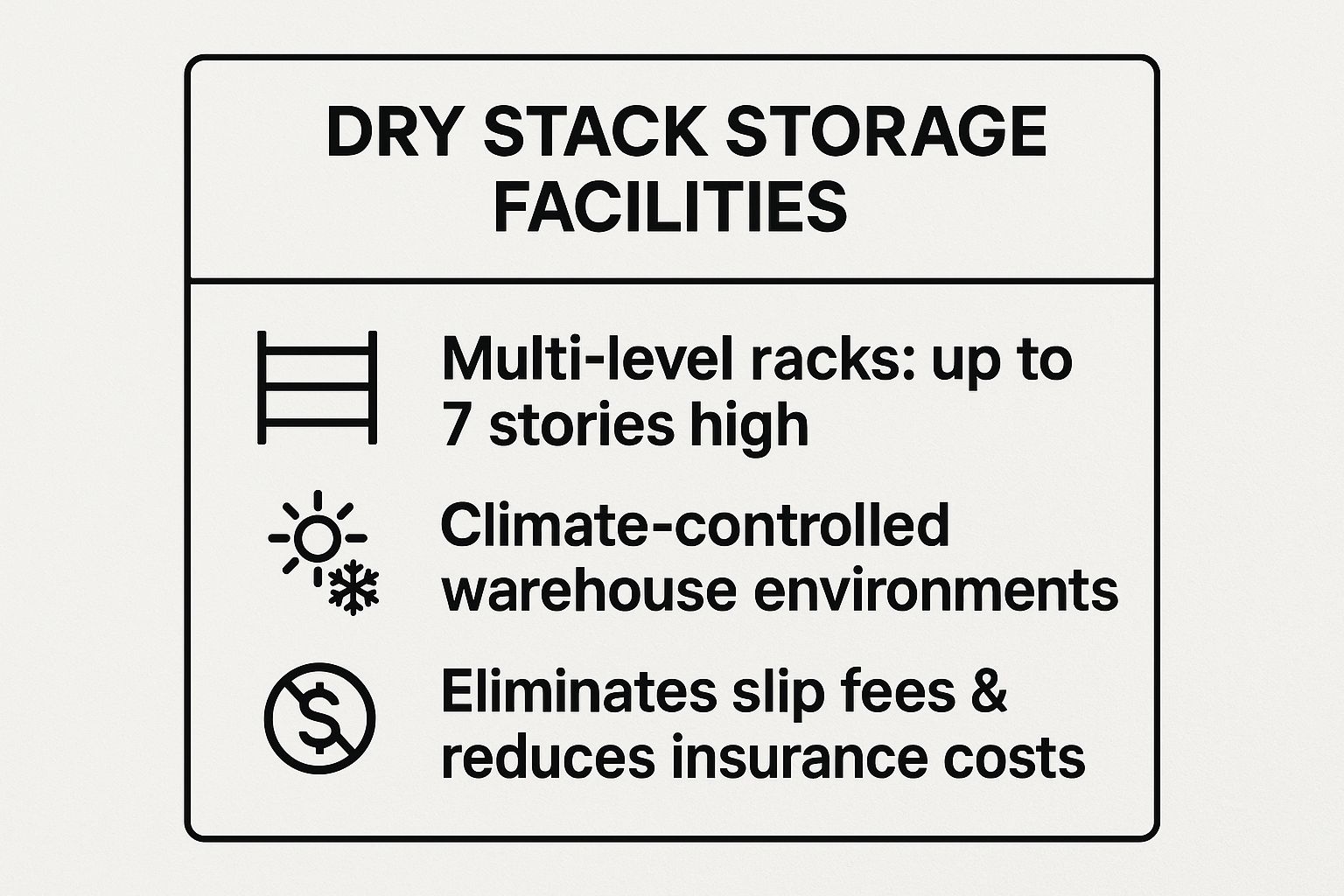
The data clearly shows how these facilities leverage vertical space and controlled environments to offer a superior alternative to traditional slips, often leading to lower insurance premiums and eliminating slip fees.
Actionable Tips for Choosing a Facility
Before committing to a dry stack facility, it's crucial to perform due diligence to ensure your investment is in good hands.
- Verify Insurance and Training: Confirm the facility has comprehensive insurance covering any potential damage during lifting and handling. Ask about their staff's training and certifications for operating heavy machinery.
- Check Access and Notice Policies: Understand the marina's operating hours and how much advance notice is required to launch your boat. Some have 24/7 access, while others require a day's notice.
- Inspect the Equipment: Visit the facility and visually inspect the condition of the forklifts and rack systems. Well-maintained equipment is a sign of a professional and safe operation.
- Consider Location: Choose a facility that is conveniently located near your home or your preferred boating areas to maximize your time on the water.
2. Boat Lifts and Hoists
For boat owners with waterfront property or a dedicated slip, a boat lift or hoist is a premier at-home storage solution. These mechanical systems are installed directly at a dock and use electric, hydraulic, or manual power to lift your vessel completely out of the water. This approach keeps your boat ready for use at a moment's notice while providing excellent protection from the marine environment, making it one of the most convenient and effective boat storage ideas available.
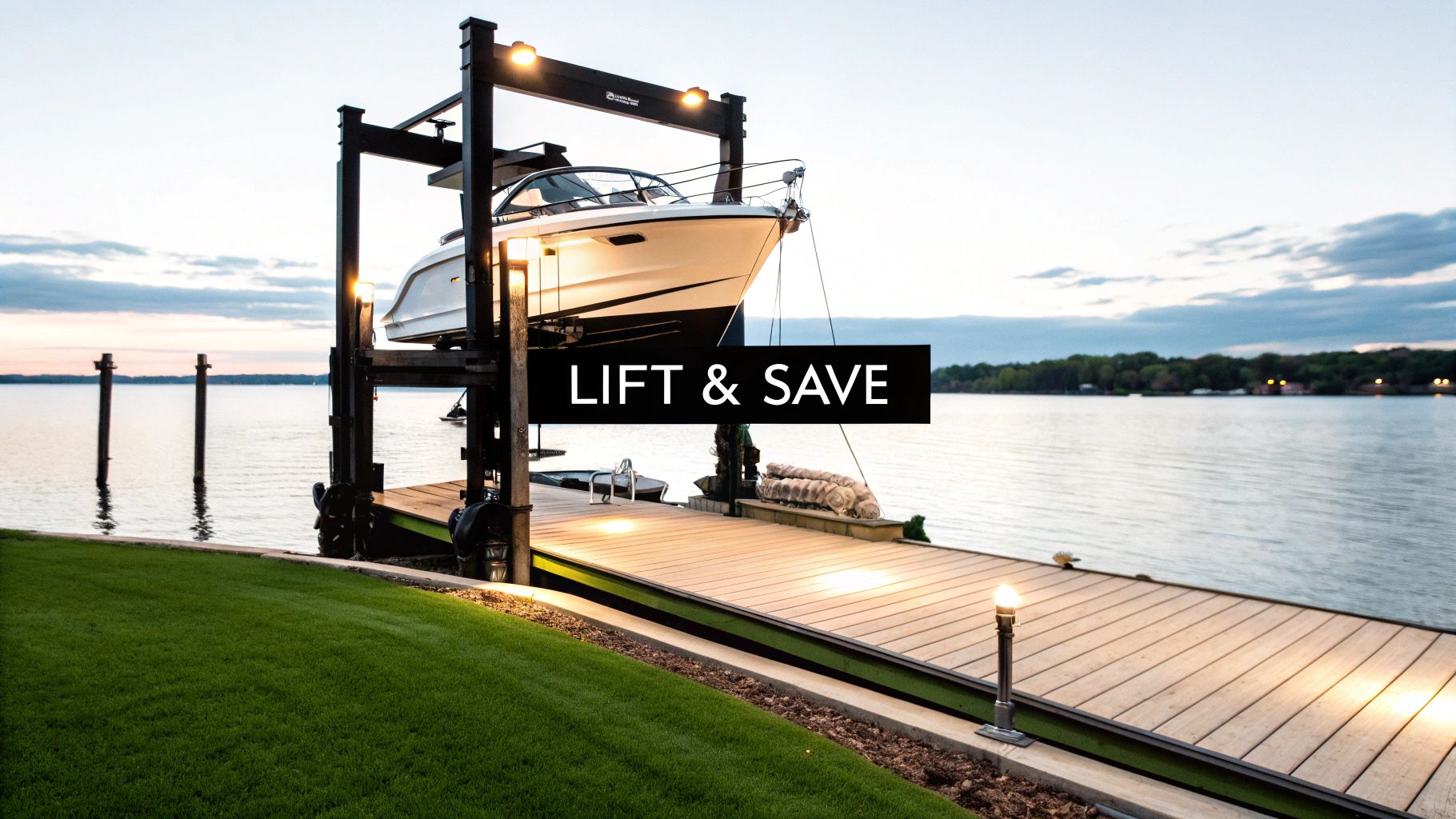
Industry leaders like ShoreStation, a pioneer since 1959, and hydraulic specialists like HydroHoist have made these systems highly reliable. Whether it's a Boat Float lift in the Carolinas or a Golden Boat Lifts installation, the concept is the same: elevate the boat above the water level. This prevents marine growth, hull blistering, and galvanic corrosion without the need to trailer your boat or rely on a marina service. Access is as simple as lowering the lift, making spontaneous trips effortless.
Key Benefits and Considerations
The main advantage of a boat lift is the blend of immediate access and superior protection. By keeping the hull dry, you drastically reduce maintenance costs and preserve the boat's finish and value. Lifts also secure the vessel against storm surges, waves, and casual theft. Unlike trailering, there's no need for a tow vehicle, ramp lines, or launching hassles. Many systems can be operated with a remote control, adding a layer of modern convenience.
Before installation, it is crucial to understand the engineering and safety requirements. You can discover the essentials of boat lift selection and safety to ensure your setup is both effective and secure. Properly installed lifts offer peace of mind, knowing your boat is safe from both environmental and security threats right at your own dock.
Actionable Tips for Choosing a Lift
Selecting and installing the right boat lift is a significant investment that requires careful planning. Follow these tips to ensure a successful and long-lasting installation.
- Size the Lift Correctly: Always choose a lift with a weight capacity at least 25% greater than your boat's fully loaded (wet) weight. This includes fuel, water, gear, and any added equipment.
- Choose Corrosion-Resistant Materials: If you are in a saltwater environment, insist on materials like marine-grade aluminum and stainless steel hardware to prevent rapid corrosion and failure.
- Ensure Proper Electrical Installation: All electrical components must be marine-grade and installed by a licensed electrician. A Ground Fault Circuit Interrupter (GFCI) is essential for safety.
- Prioritize Regular Maintenance: Inspect cables, bunks, and motors regularly. Lubricating moving parts and checking for wear can prevent catastrophic failures and expensive repairs.
3. Covered Boat Storage Buildings
For boat owners with available property, a dedicated covered storage building offers a permanent, private, and highly effective solution. These purpose-built structures are designed with high ceilings and extra-wide doors to accommodate the specific dimensions of boats, trailers, and even masts. This method provides complete protection from sun, rain, snow, and hail, making it one of the most secure boat storage ideas for long-term preservation right on your own land.
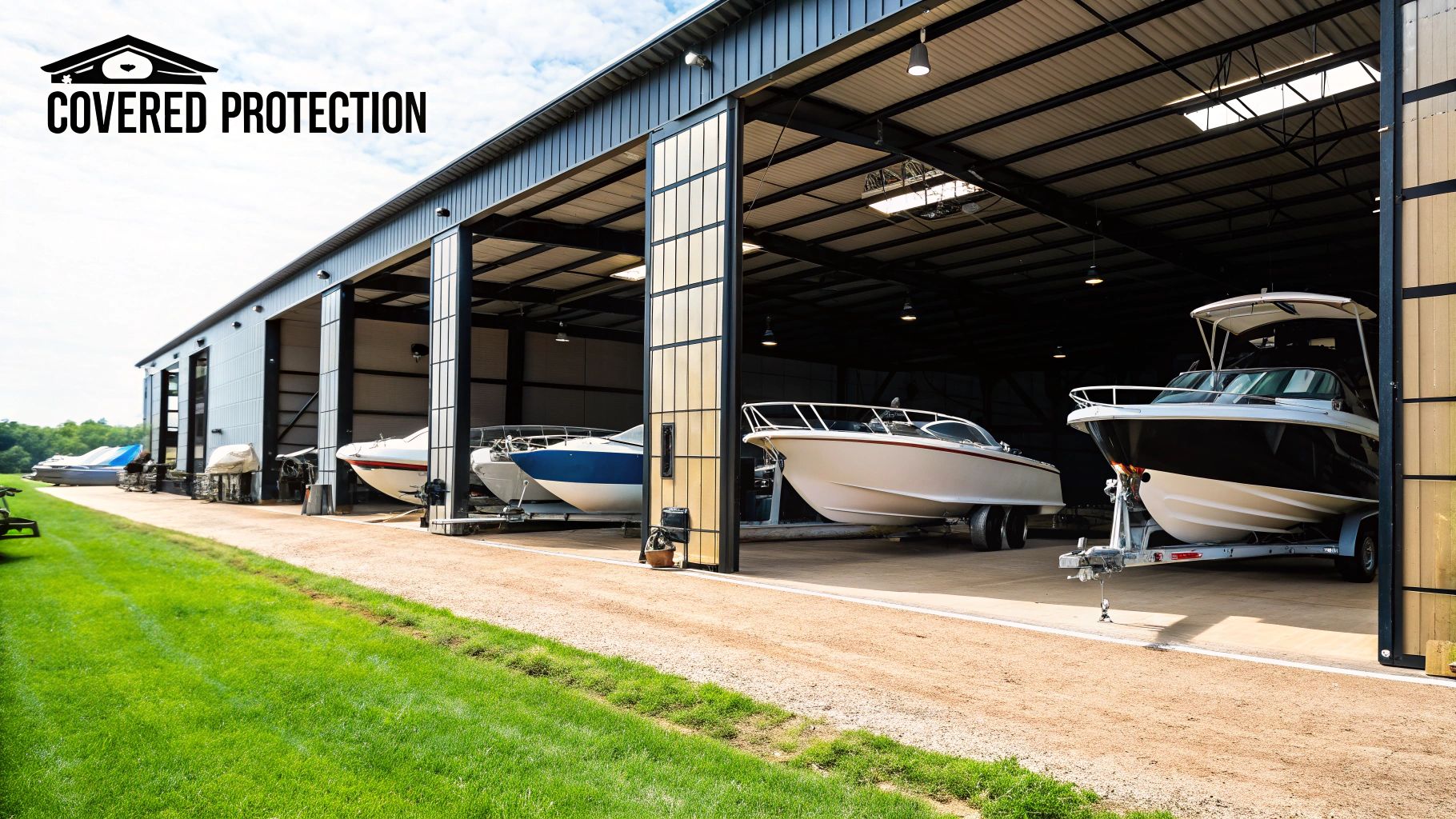
Leading manufacturers like SteelMaster Buildings, Morton Buildings, and ClearSpan have popularized this approach, offering everything from classic Quonset huts to modern steel-framed structures. The key benefit is creating a controlled environment that you own and manage. It not only shields your vessel from the elements but also provides ample space for maintenance, repairs, and storing gear like life jackets, water skis, and fishing equipment in one secure location.
Key Benefits and Considerations
The principal advantage of a dedicated boat storage building is the complete environmental control and security it offers. By enclosing your boat, you prevent UV damage that fades gelcoat, stop rain from causing water spots or pooling on covers, and eliminate the risk of damage from hail or falling debris. This significantly reduces wear and tear, preserves resale value, and minimizes the need for frequent cleaning.
Furthermore, these buildings can be customized with insulation, ventilation, and electrical systems for lighting and tool use. For those considering a dedicated, robust structure for their vessel, understanding options like a metal building specifically designed for RVs can provide valuable insights, as the requirements for large vehicles like RVs and boats are very similar. This type of investment provides unparalleled convenience and protection.
Actionable Tips for Building Your Structure
Constructing a dedicated building requires careful planning to ensure it meets your current and future needs.
- Plan for Ample Clearance: Ensure the design includes at least 3-4 feet of clearance on all sides of the boat. This provides enough room to walk around, perform maintenance, and prevent accidental scrapes.
- Install Proper Ventilation: To combat moisture and prevent condensation, which can lead to mold and mildew, install ridge vents or gable vents. Good airflow is critical in an enclosed space.
- Design Doors for Easy Access: The door is a critical feature. Make sure it is tall and wide enough to easily maneuver your boat and trailer in and out without difficulty. A roll-up door is often the most practical choice.
- Consider Insulation and Electrical: If you live in a region with extreme temperatures, insulating the building will protect your boat from heat and cold. Plan for electrical outlets to power battery chargers, tools, and lighting.
4. Boat Trailer and Driveway Storage
Storing a boat on its trailer in your driveway or on your property is one of the most common, accessible, and cost-effective boat storage ideas. This method offers unparalleled convenience, allowing you direct access to your vessel for maintenance, cleaning, and spontaneous trips. It puts you in complete control of your boat's security and condition, eliminating monthly storage fees and travel time to a separate facility.
This approach is highly popular among owners of smaller to mid-sized boats that are easily trailered. From a suburban driveway neatly fitting a ski boat under a protective cover to a dedicated spot on a rural farm property, driveway storage is a practical solution. Many boat owners, especially those with brands like Carver or using covers from Taylor Made, rely on this method for its simplicity and affordability, keeping their investment close to home.
Key Benefits and Considerations
The primary advantage of trailer storage is the significant cost savings. By avoiding slip fees or facility charges, you can allocate more of your budget to maintenance and upgrades. It also provides immediate access, making it easy to perform offseason work, load gear for a trip, or simply check on your boat without having to plan a visit to a marina.
However, this method requires diligent self-management. Your boat is exposed to the elements unless properly protected, and you are solely responsible for its security. It is crucial to use a high-quality, weather-resistant boat cover to shield the gelcoat, upholstery, and electronics from UV damage, rain, and debris. Furthermore, you must consider local regulations, as many HOAs and municipal zoning laws have strict rules about storing boats and trailers on residential properties.
Actionable Tips for Secure Driveway Storage
Properly preparing your boat and trailer for driveway storage is essential for preventing damage and ensuring it remains in top condition.
- Invest in a Quality Cover: Choose a durable, breathable, and well-fitting cover from a reputable brand like Classic Accessories or Budge. A good cover prevents sun damage and stops moisture from getting trapped, which can lead to mold and mildew.
- Support the Trailer and Boat: Use trailer blocks or jack stands to take the weight off the tires, preventing flat spots and extending their life. Ensure the boat is level and well-supported on the trailer bunks to avoid putting stress on the hull.
- Check Local Regulations: Before parking your boat, thoroughly review your local zoning ordinances and Homeowners Association (HOA) rules. Some communities have restrictions on the visibility, duration, and placement of recreational vehicles.
- Implement Security Measures: Use a high-quality hitch lock and consider a wheel lock to deter theft. Parking in a well-lit, visible area or behind a locked gate can also add a significant layer of security.
5. Self-Storage Unit Boat Storage
For boat owners needing a secure, accessible, and flexible off-site solution, renting a self-storage unit is a highly practical option. This approach involves leasing a specific unit within a professional facility designed to accommodate vehicles like boats and RVs. It offers a private, enclosed space that protects your vessel from weather, sun damage, and potential theft, serving as an excellent alternative to leaving it exposed in a driveway or yard.
Major national providers like Public Storage and Extra Space Storage have dedicated facilities with units large enough for trailerable boats. These locations offer a controlled environment where your boat remains safe behind gated access and under video surveillance. This method combines the security of professional oversight with the convenience of individual access, making it one of the most popular boat storage ideas for owners without adequate home storage.
Key Benefits and Considerations
The primary advantage of using a self-storage facility is the balance of security, accessibility, and cost-effectiveness. It provides robust protection from the elements, which helps preserve your boat's gelcoat, upholstery, and onboard equipment. Many facilities offer 24/7 keypad access, allowing you to retrieve or work on your boat according to your own schedule, a level of flexibility not always available at marinas.
While standard units offer great protection, opting for a climate-controlled unit is ideal in regions with extreme temperatures or high humidity. This premium feature prevents moisture buildup, which can lead to mold, mildew, and corrosion, ensuring your boat stays in pristine condition during long-term storage. For those winterizing their boat, a climate-controlled space provides the ultimate protective environment. More information on preparing your boat for storage can be found in this BoatUS winterizing guide.
Actionable Tips for Choosing a Facility
Selecting the right self-storage facility is crucial for ensuring your boat is safe and accessible when you need it.
- Measure Everything: Before renting, measure the total length, width, and height of your boat on its trailer. Pay special attention to the height, including any Bimini tops or antennas, to ensure it will clear the unit's roll-up door.
- Verify Security Features: Tour the facility and confirm it has essential security measures like perimeter fencing, electronic gate access, good lighting, and 24-hour video surveillance.
- Confirm Insurance Policies: Check with both the storage facility and your boat insurance provider. Some facilities require proof of insurance, and you'll want to ensure your policy covers off-site storage.
- Inquire About Access and Amenities: Ask about access hours, whether the facility offers power outlets for trickle chargers, and if there are on-site wash-down stations available for use.
6. Marina Wet Slip Storage
Marina wet slip storage is the classic and most recognized method for keeping a boat. It involves leasing a designated space, or "slip," at a marina where your vessel remains floating in the water, secured to a dock. This approach offers unparalleled, immediate access to the water, making it one of the most convenient boat storage ideas for avid boaters who want to get out on the water with minimal notice.
Prominent marina operators like IGY Marinas and Westrec Marinas offer extensive wet slip facilities that cater to a wide range of vessel sizes. The concept is simple: your boat is tied up with dock lines and protected by fenders, ready to go whenever you are. This eliminates the need for trailering or scheduling a launch, providing a true "walk-on, walk-off" boating experience that many owners prioritize above all else.
Key Benefits and Considerations
The primary advantage of a wet slip is the supreme convenience it offers. Your boat is always in the water, allowing for spontaneous trips without the delays associated with dry storage. This is ideal for boaters who use their vessel frequently, especially during peak season. Wet slips also foster a sense of community, as you are surrounded by fellow boat owners and have easy access to marina amenities like fuel docks, pump-out stations, and clubhouses.
However, this constant water exposure requires diligent maintenance. The hull is susceptible to marine growth like algae and barnacles, necessitating regular bottom cleaning and the application of anti-fouling paint. Additionally, the boat is continuously exposed to weather, sun, and saltwater, which can accelerate wear and tear on its finish, systems, and zinc anodes.
Actionable Tips for Choosing a Wet Slip
Selecting the right wet slip is about more than just finding an empty space; it's about securing a safe and suitable home for your vessel.
- Assess Weather Protection: Look for slips in well-protected areas of the marina, away from heavy main channel traffic and prevailing winds or waves. A calm, sheltered slip significantly reduces stress on your boat and dock lines.
- Inspect Dock Conditions: Check the condition of the docks, cleats, and utility hookups (power and water). Ensure they are well-maintained and robust enough for your vessel. Floating docks are often preferable as they adjust to water level changes.
- Use Quality Gear: Invest in high-quality, appropriately sized dock lines with chafe guards to prevent wear. Use an adequate number of durable fenders to protect your hull from contact with the dock.
- Confirm Insurance and Rules: Review your insurance policy to ensure it covers wet slip storage, as some policies have specific requirements. Familiarize yourself with all marina rules and regulations before signing a lease.
7. Boat Shrink Wrapping Systems
Boat shrink wrapping is a highly effective method for protecting a vessel during long-term storage, especially over the winter. This process involves covering the entire boat with a specialized, heavy-duty polyethylene plastic film. Once draped over the boat, the film is heated with a tool like a propane heat gun, causing it to shrink and conform tightly to the boat's contours. This creates a durable, drum-tight, and waterproof barrier that shields the vessel from the elements.
This method has become a go-to for professional marinas and dedicated boat owners alike. Companies like Dr. Shrink and Cornerstone Products offer comprehensive systems with all the necessary materials, from the wrap itself to vents, tape, and support structures. Alternatively, many mobile service companies and full-service marinas offer professional shrink wrapping as a convenient, hands-off solution for seasonal storage.
Key Benefits and Considerations
The primary advantage of shrink wrapping is its superior protection against snow, ice, rain, and UV damage. Unlike a simple tarp, a properly installed shrink wrap cover will not flap in the wind, which prevents chafing against the hull and gelcoat. The tight seal also deters pests and keeps the boat clean from dirt and debris. This method is one of the most versatile boat storage ideas, suitable for boats of all sizes stored on trailers, in boatyards, or even in a backyard.
Proper installation is critical for the wrap to be effective. The process includes building a support frame underneath the plastic to ensure it sheds water and snow, preventing pooling that could cause damage. You can find detailed instructions and professional advice in this complete guide on how to shrink wrap a boat. Ensuring this is done correctly preserves your boat's condition through the off-season.
Actionable Tips for Shrink Wrapping
To get the most out of this storage method, proper preparation and execution are essential. Follow these tips for a successful and safe wrap.
- Ensure Proper Ventilation: Install vents in the shrink wrap to allow air to circulate. This is crucial for preventing moisture buildup, which can lead to mold and mildew growth inside the boat and on upholstery.
- Build a Strong Support Structure: Use strapping and support poles to create a robust framework under the wrap. This structure must be strong enough to bear the weight of snow and ice, preventing the wrap from sagging or tearing.
- Pad All Sharp Edges: Before applying the wrap, cover any sharp corners or objects like windshield frames, cleats, and antenna mounts with padding. This prevents the wrap from puncturing or tearing as it shrinks.
- Hire a Certified Professional if Unsure: While DIY kits are available, a professional installer has the experience and specialized equipment to ensure a perfect, durable fit. This is often a worthwhile investment for high-value boats.
Boat Storage Options Comparison
| Storage Method | Implementation Complexity 🔄 | Resource Requirements ⚡ | Expected Outcomes 📊 | Ideal Use Cases 💡 | Key Advantages ⭐ |
|---|---|---|---|---|---|
| Dry Stack Storage Facilities | High (hydraulic lifts, multi-level racks) | High (warehouse, trained staff, equipment) | Protects hull from marine growth, reduces insurance costs | Long-term, secure, space-efficient storage | Space-efficient; protects hull; eliminates slip fees |
| Boat Lifts and Hoists | Medium-High (installation, permits) | High (lift machinery, power supply) | Protects hull, easy access, reduces theft risk | Private docks, marinas needing quick access | Instant access; protects from storms; theft reduction |
| Covered Boat Storage Buildings | High (construction, permits) | Very High (large structure, ventilation) | Full weather protection, supports maintenance | Multi-boat storage; winter maintenance | Comprehensive weather protection; organized storage |
| Boat Trailer and Driveway Storage | Low (minimal setup) | Low (trailer, cover optional) | Cost-effective, basic protection, full owner control | Cost-conscious owners; frequent travel | Lowest cost; full control; easy transport |
| Self-Storage Unit Boat Storage | Medium (unit rental, measurements) | Medium (rental cost, access control) | Secure, weather-protected, flexible lease | Owners needing security and climate control | Security; weather protection; flexible rental |
| Marina Wet Slip Storage | Low-Medium (slip rental, dock access) | Medium (monthly fees, utilities) | Immediate water access, social environment | Frequent boaters wanting convenience | Instant access; social atmosphere; utilities provided |
| Boat Shrink Wrapping Systems | Medium (professional installation) | Medium (materials, professional service) | Superior weather, UV protection; seasonal long-term cover | Seasonal storage; weather protection | Excellent weather/UV protection; pest/dust barrier |
Making the Right Choice for Your Vessel
Navigating the world of boat storage can feel as complex as charting a new course on the water. Throughout this guide, we've explored a diverse fleet of options, from the high-tech convenience of dry stack facilities and private boat lifts to the practical, budget-friendly approach of driveway storage with a high-quality cover or professional shrink wrapping. Each of these boat storage ideas presents a unique balance of cost, convenience, security, and protection, ensuring there is a perfect solution for every type of vessel and owner.
The ultimate goal is to find an option that seamlessly integrates with your lifestyle. The avid angler who hits the water at a moment's notice might find the immediate access of a wet slip or a boat lift indispensable. In contrast, the seasonal sailor in a harsh climate will benefit most from the robust, long-term protection offered by covered storage buildings or a meticulous shrink-wrapping job.
Key Considerations for Your Final Decision
Before you commit, it's crucial to distill your needs into a clear set of priorities. This process will guide you toward the most logical and beneficial storage solution.
- Frequency of Use: How often do you use your boat? If you're out every weekend, convenience is paramount. A dry stack facility or a personal lift offers grab-and-go access that driveway or self-storage units can't match.
- Climate and Environment: Consider your local weather. Is your area prone to intense sun, heavy snow, or hurricanes? A fully enclosed, climate-controlled unit provides the ultimate defense against the elements, while a simple boat cover might be sufficient in a milder region.
- Budgetary Constraints: Your financial plan is a major factor. While a marina slip or a custom boat lift represents a significant investment, options like driveway storage are highly cost-effective, freeing up funds for maintenance and upgrades.
- Security Needs: How secure is the area where you plan to store your vessel? Gated facilities, such as professional storage buildings or marinas with surveillance, offer peace of mind that is often worth the extra cost.
Protecting Your Investment for Future Adventures
Choosing the right storage method is more than a logistical decision; it's a fundamental part of responsible boat ownership. The right choice protects your vessel from UV damage, moisture, pests, and theft, preserving its value and structural integrity for years to come. Proper storage significantly reduces the wear and tear that occurs when a boat is left exposed, meaning less time and money spent on repairs and more time enjoying the water.
Ultimately, by carefully weighing these factors and implementing the right boat storage ideas, you are not just protecting a physical asset. You are safeguarding the experiences, memories, and adventures that your boat makes possible. Making an informed decision now ensures that your vessel remains ready and waiting for your next journey, season after season.
No matter where you store your vessel, preparing it with the right products is essential for its long-term health. From powerful hull cleaners and vinyl conditioners to durable mooring lines, Better Boat provides the premium supplies you need to protect your investment. Explore our complete collection at Better Boat to ensure your boat is perfectly prepped for storage and ready for launch day.


